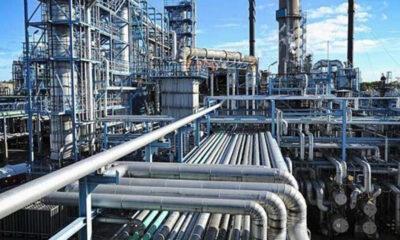Business
FAO: 9.8 million people in FCT, 16 northern states battling hunger

An agency of the United Nations, Food and Agriculture Organisation says at least 9. 8 million people living in 15 northern Nigerian states and the Federal Capital Territory (FCT) are suffering from food insecurity.
It said the findings were the outcome of a food analysis made available on Thursday.
It specifically stated that Abuja, Borno, Adamawa, Yobe, Benue, Gombe, Taraba, Katsina, Jigawa states were struggling with food insecurity and malnutrition.
Others are “Kano, Bauchi, Plateau, Kaduna, Kebbi, Sokoto, Niger and the FCT,” it stated.
Speaking at the presentation of the analysis, the FAO Representative in Nigeria and the ECOWAS, Fred Kafeero, said the results of the analysis had exposed the need for urgent intervention by the government.
“The presentation of the results of the October/November 2020 Cadre Harmonise (CH) analysis for the 16 states and the Federal Capital Territory of Nigeria is such an important stage in determining our next actions and effective response In ensuring food security and nutrition in the country.
“The Cadre Harmonlse or CH (as is popularly called) is a regional framework for the consensual analysis of acute food and nutrition insecurity situations across West African countries through these framework areas of risk of mal-and undernourishment and the food insecure populations are identified.”
He said, “The exercise, which has now been adopted by the Nigeria Food Security stakeholders since 2015 aims at applying the outcome of the analysis in preventing food crisis by identifying the areas affected and the populations as well as proffering appropriate measures towards improved food and nutrition security and livelihoods.
“Distinguished guests, ladies and gentlemen, I am pleased to inform you that the CH analysis results in Nigeria have become the major yardstick for estimating the areas and population of vulnerable people in need of humanitarian assistance as presented in the annual Humanitarian Needs Overviews (HNOs) and the Humanitarian Response Plans (HRPs) especially in the three BAY states of NE.
“This October/November 2020 CH analysis happens to be different from the previous years, as it took Into consideration the unprecedented impact of the COVID -19 pandemic on the various outcomes of FNS and the inference of the various FNS contributing factors.
“Despite the relaxation of the COVlD-19 lockdown measures, several households are still currently experiencing difficulties in accessing their basic food and nonfood needs due to disrupted livelihoods. This has resulted in reduced HHs opportunities for income and food and nutrition security.”
The result of the analysis also projects that 13.9 million people may suffer from food insecurity from the affected states in 2021.
Kafeero explained further that “in this context, FAO and partners have adapted their programme to respond to the Increased need. For the 2020 rainy season In NE, FAO reached 63,300 HH with quality seeds and fertilizers distribution.
“Another 12,000 HH have been reached with livestock support. We are planning to reach about 19,000 HH for the upcoming dry season in collaboration with the FMARD, WFP and IFAD.
“The exercise, which has now been adopted by the Nigeria Food Security stakeholders since 2015 aims at applying the outcome of the analysis in preventing food crisis by identifying the areas affected and the populations as well as proffering appropriate measures towards improved food and nutrition security and livelihoods.”
Business
Nigeria’s foreign reserves in marginal increase, now $40.88bn

Nigeria’s foreign reserves in marginal increase, now $40.88bn
Nigeria’s foreign reserves rose to $40.88 billion as of November 21, the Governor of the Central Bank of Nigeria (CBN), Olayemi Cardoso, has said.
Cardoso disclosed this on Tuesday at a press conference after the Monetary Policy Committee’s 298th meeting in Abuja.
He said the external reserves grew from $40.06 billion at the end of October to $40.88 billion in November.
The amount represents an increase of $82 million or 2.05 per cent in 21 days.
“The external reserves rose marginally to 40.88 billion as of 21 November 2024, from 40.06 billion at the end of October 2024, available to finance 17 months of imports,” he said.
However, from the apex bank’s website, the increase in Nigeria’s foreign reserves showed $40.27 billion on November 22.
Cardoso also said, “The process of getting us where we are in terms of reserves has been a long one”.
“It is a clear indication that the policies we have put in place are certainly yielding fruits,” he added.
“However, and it’s very important to make a distinction here and to reiterate the fact that reserves are there for a multiplicity of different purposes, not least of which is to create buffers in the event of unanticipated shocks.
“So they are not there to simply whittle away. They are there to be used to more or less defend yourself where that becomes necessary
“And when we talk about shocks that are not anticipated, I think we can see how the global economies are.”
Cardoso also said the bank would continue to intensify efforts to stabilise the currency and prices.
The CBN governor said, “The currency has been stable compared to what it was in June”.
But he said for the value of the country’s currency to be stable, there must be increased exports and diversification of the economy.
Cardoso said diaspora remittance had increased due to policies put in place.
He commended those in the diaspora for helping the country accomplish over $600 million in remittances.
Business
Naira rises to N1,755/$ in parallel market

Naira rises to N1,755/$ in parallel market
The Naira yesterday appreciated to N1,755 per dollar in the parallel market from N1,770 per dollar on Monday.
Similarly, the Naira appreciated to N1,659.44 per dollar in the Nigerian Autonomous Foreign Exchange Market, NAFEM.
Data from FMDQ showed that the indicative exchange rate for NAFEM fell to N1,659.44 per dollar from N1,675.62 per dollar on Monday, indicating N16.18 appreciation for the naira. The volume of dollars traded (turnover) increased by 219.5 percent to $425.98 million from $108.79 million traded on Monday.
READ ALSO:
- Nigeria Customs returns 21 stolen luxury vehicles to Canada
- Pro-Wike Rivers lawmakers move to prevent probe of FCT minister tenure as governor
- Bianca raises hope Tinubu will free Nnamdi Kanu to restore peace in South-East
Consequently, the margin between the parallel market and NAFEM rate narrowed to N95.56 per dollar from N117.38 per dollar on Monday.
Naira rises to N1,755/$ in parallel market
Business
PH refinery to blend 1.4-million litre petrol daily – NNPC

PH refinery to blend 1.4-million litre petrol daily – NNPC
Rehabilitated old Port Harcourt refinery is currently operating at 70 per cent of its installed capacity, the Nigerian National Petroleum Company Limited has said.
The Port Harcourt Refining Company (PHRC) operates two refineries: the old refinery with a capacity of 60,000 barrels per stream day (bpsd) and a new refinery with an installed capacity of 150,000 bpsd.
The NNPCL in a statement on Tuesday, said it planned to increase the operation to 90 per cent of the refinery’s capacity.
“The Board and Management of the Nigerian National Petroleum Company Limited (NNPC Ltd) express heartfelt appreciation to Nigerians for their support and excitement over the safe and successful restart of the 60,000 barrels-per-day Old Port Harcourt Refinery,” the statement reads.
“This achievement marks a significant step forward after years of operational challenges and underperformance.
“We are, however, aware of unfounded claims by certain individuals suggesting that the refinery is not producing products. For clarity, the Old Port Harcourt Refinery is currently operating at 70% of its installed capacity, with plans to ramp up to 90%.”
According to NNPC, the refinery has commenced production of daily outputs of straight-run petrol (naphtha), which is blended into 1.4 million litres of petrol.
The national oil company said the refinery has also started producing 900,000 litres of kerosene per day and 1.5 million litres per day of diesel.
The NNPC said 2.1 million litres daily volume of low-pour fuel oil (LPFO) would also be produced at the refinery, adding that additional volumes of liquefied petroleum gas (LPG) will be refined at the plant.
“It is worth noting that the refinery incorporates crack C5, a blending component from our sister company, Indorama Petrochemicals (formerly Eleme Petrochemicals), to produce gasoline that meets required specifications,” NNPC said.
“Blending is a standard practice in refineries globally, as no single unit can produce gasoline that fully complies with any country’s standards without such processes.”
Additionally, the NNPC said it has made substantial progress on the new Port Harcourt refinery, “which will begin operations soon without prior announcements”.
“We urge Nigerians to focus on the remarkable achievements being realized under the able and progressive leadership of President Bola Tinubu and to support efforts aimed at delivering more dividends to the nation,” the energy firm said.
According to the statement, malicious attacks on “clear progress” only undermine the “significant strides made by NNPC Ltd and the country”.
-

 metro24 hours ago
metro24 hours agoBREAKING: Port Harcourt refinery begins operation
-

 Business3 days ago
Business3 days agoJust in: Dangote refinery reduces petrol price for marketers
-

 metro2 days ago
metro2 days ago40-foot container falls on car in Lagos
-

 Politics2 days ago
Politics2 days agoLagos 2027: Seyi Tinubu campaign team releases his life documentary
-

 International2 days ago
International2 days agoTrump to sack 15,000 transgender officers from U.S. military: Report
-

 Education17 hours ago
Education17 hours agoUS University opens 2025 scholarships for international students
-

 Entertainment2 days ago
Entertainment2 days agoPolygamy best form of marriage for Africa – Okey Bakassi
-

 Sports18 hours ago
Sports18 hours agoFrench football star, Paul Pogba’s blackmail trial begin in Paris















You must be logged in to post a comment Login